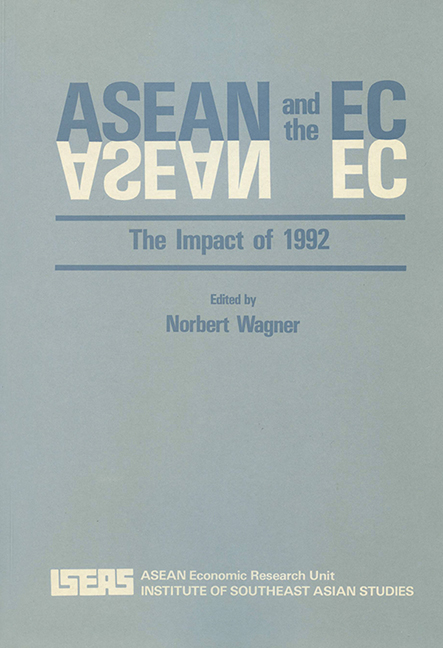Book contents
- Frontmatter
- Contents
- List of Tables
- List of Figures
- Acknowledgements
- PART I INTRODUCTION
- PART II COMPLETING THE EC INTERNAL MARKET
- PART III IMPLICATIONS FOR ASEAN
- V An Analysis of ASEAN-EC Trade in Textiles and Electronics, 1980–88
- VI The EC Internal Market and the ASEAN Electronics Industry
- VII The EC Internal Market and the ASEAN Textile and Clothing Industry
- VIII The Harmonization of Technical Standards and Regulations in the EC: Implications for ASEAN
- IX The EC Internal Market and ASEAN-EC Trade in Services
- X The EC Internal Market and ASEAN-EC Direct Investment Flows
- XI The European Currency System and ASEAN
- Contributors
XI - The European Currency System and ASEAN
from PART III - IMPLICATIONS FOR ASEAN
Published online by Cambridge University Press: 09 November 2017
- Frontmatter
- Contents
- List of Tables
- List of Figures
- Acknowledgements
- PART I INTRODUCTION
- PART II COMPLETING THE EC INTERNAL MARKET
- PART III IMPLICATIONS FOR ASEAN
- V An Analysis of ASEAN-EC Trade in Textiles and Electronics, 1980–88
- VI The EC Internal Market and the ASEAN Electronics Industry
- VII The EC Internal Market and the ASEAN Textile and Clothing Industry
- VIII The Harmonization of Technical Standards and Regulations in the EC: Implications for ASEAN
- IX The EC Internal Market and ASEAN-EC Trade in Services
- X The EC Internal Market and ASEAN-EC Direct Investment Flows
- XI The European Currency System and ASEAN
- Contributors
Summary
The Challenge of the European Currency System for ASEAN?
The single European market in 1992 has become a major point of interest in our world today. The programme is expected to produce not only substantial changes in different areas within the European Community (EC) but in other countries as well. In the mean time, countries outside the EC have started to dwell seriously on the potential impact of such a programme upon their own economies.
While the countries of the Association of Southeast Asian Nations (ASEAN) enjoy close economic relations with the EC, they also follow closely the activities centring around 1992. Their concerns are mainly concentrated in the real sector of international trade in goods and services and international investment. These two areas are in fact at the very core of economic ties between the two regional groupings. The EC's move towards 1992 means that the ASEAN countries have to adjust themselves in these sectors so as to be more competitive in the coming years. The famous fearful jargons of the time include “standards of goods”, “reciprocity”, “rules of origins”, while a magical message speaks of twelve markets being opened as never before. Whether or not one likes it, the wheels of the EC single market programme are already set in motion and the EC invites everyone to participate and become accustomed with it from now on.
Because of the cautious way the European Currency System (ECS) presented its programmes initially, the ASEAN countries appeared to be less preoccupied with the ECS during current formulations held at different forums. It was only after the Madrid summit in June 1989 that the EC began to shed some light on a more interesting direction for the ECS. It is in ASEAN's interest to see how such a system can contribute to the stability of exchange rates in tomorrow's world and to see what part ASEAN can play in the new system.
- Type
- Chapter
- Information
- ASEAN and the ECThe Impact of 1992, pp. 318 - 342Publisher: ISEAS–Yusof Ishak InstitutePrint publication year: 1991

